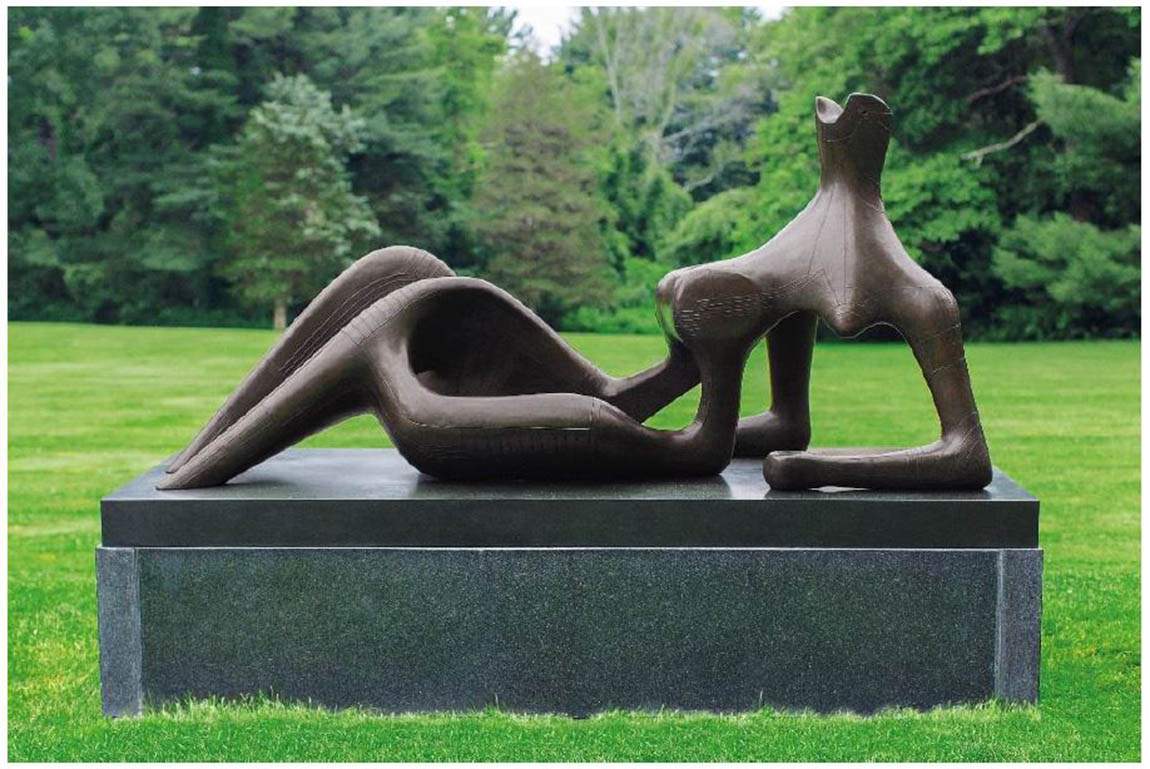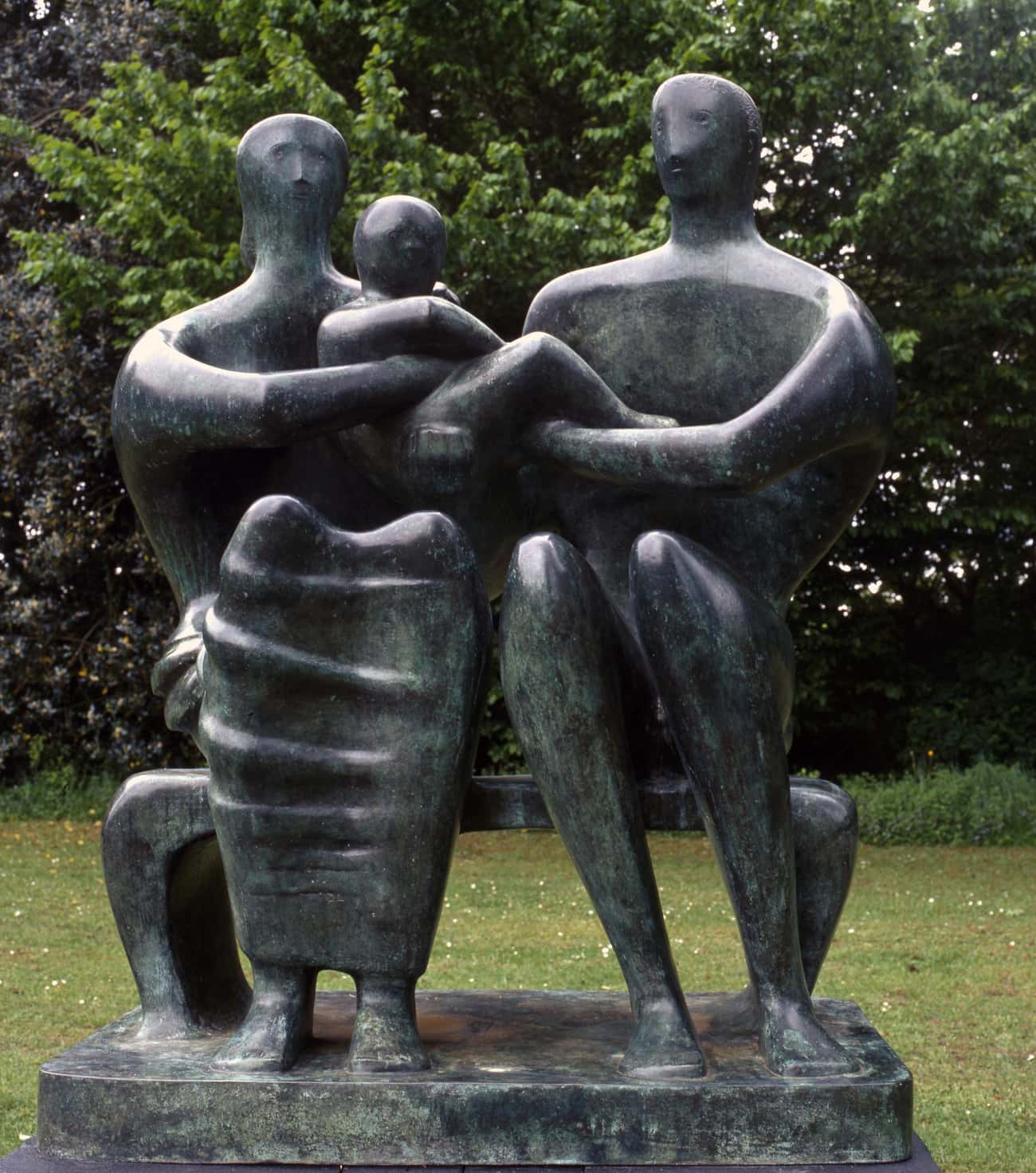
Reclining Figure by Henry Moore Henry moore sculptures, Sculpture art, Sculpture
Henry Moore Biography. Henry Moore was a major British sculptor whose organically shaped, semiabstract, and often monumental bronze and stone figures made him one of the most important sculptors of the 20th century. Born into a Yorkshire coal-mining family on July 30, 1898, Moore started training as a schoolteacher, until he was called to serve.

Henry Moore; "The Archer" (Bronze sculpture) on the terrace of the Neue Nationalgalerie, 19645
Legacy. In 1977, aged 79, Moore's success was such that he decided with his family to establish the Henry Moore Foundation. He wanted to encourage wide enjoyment and opportunity in the arts and in particular sculpture. Moore worked for the Foundation for a further nine years until, in August 1986 he died at home in Perry Green.

Henry Moore Un destacado de la escultura, lo abstracto y lo atrevido Fahrenheit Magazine
See all 29 artworks ›. Large Interior Form, 1953/54. Henry Moore. Working Model for UNESCO Reclining Figure, 1957. Henry Moore. Sculpture, 1935. Henry Moore. Two Reclining Figures with River Background, 1963. Henry Moore.

Henry Moore Bronze Sculpture For Sale Vincentaa
Browse and buy sculptures, drawings and prints by Henry Moore, check auction results and learn about their history.

Henry Moore Skulpturen Nolde Stiftung Seebüll
Carving a Reputation: The 1920s . Henry Moore was born and raised in Yorkshire, a rugged mining region in northern England. After serving in the trenches of World War I, he studied and then taught at the Royal College of Art in London--a stronghold of academic formalism that afforded students few opportunities to explore nontraditional sources for their art.

GROßE Spindel Henry Moore Skulpturen bilden eine offene Ausstellung in Kensington Gardens 1978
The Arch, 1963-69. The Arch is a large outdoor public art sculpture that Henry Moore made between 1963-69. The inspiration for this 6-metre tall, arching form came from a piece of bone. Using the bone as a starting point allowed Moore to connect his artwork with the inner structures of the human body.

Sculptor Henry Moore
Family Group (1950) by Henry Moore, located at the Barclay School in Hertfordshire in the United Kingdom; Henry Moore, CC BY-SA 2.0, via Wikimedia Commons. In 1950, he produced Family Group, his earliest large-scale bronze, which was requested by a school in Stevenage.Moore's public projects were in high demand throughout the 1950s. Prices for his works skyrocketed, and his reputation as an.

henry moore sculpture Google Search Henry moore sculptures, Sculpture, Henry moore
Save on All Your Favorite Titles Online or In-store at AbeBooks. With so Many Great Releases, We Have the Perfect Book for You! Shop Now.

henry moore Henry moore, Henry moore sculptures, Sculpture
List of sculptures by Henry Moore. Henry Moore, standing next to his sculpture. This article lists a selection of notable works created by Henry Moore. The listing follows the list of works within the 1988 book Sculpture by Henry Moore [1] and links to images of the Henry Moore Artwork Catalogue. [2]

Henry Moore bronze sculpture "Sheep Piece 19711972" by brian17302 ePHOTOzine
Henry Moore is widely regarded as one of Britain's finest artists. His career spanned more than six decades, and his work continues to be considered highly collectible the world over. Although he is known predominantly for his large, curvaceous sculptures of reclining nudes, he was an artist who also worked with a variety of media, styles and.

GroundBreaking Henry Moore Sculpture Also RecordBreaking At 33.1 MillionAntiques And The Arts
This collection details all of Henry Moore's sculptural output from 1915 to 1986, and will become a summary of the works contained within the 6-volume Henry Moore: Complete Sculpture published by Lund Humphries between 1944 and 2003. Each work is shown as an individual summary record, and if it was cast then details of the edition and foundry.
.jpg)
Henry Moore (18981986) , Oval Sculpture Christie's
We welcome anyone with an interest in Henry Moore, his life and his work. The archive contains over three quarters of a million objects and documents relating to Moore, dating back to 1914. You can view material at your leisure in our dedicated, spacious reading room. Open by appointment year-round, Monday to Friday, 10:00-16:30.

Famous Henry Moore Sculptures List of Popular Henry Moore Sculptures
Henry Moore (born July 30, 1898, Castleford, Yorkshire, England—died August 31, 1986, Much Hadham, Hertfordshire) English sculptor whose organically shaped, abstract, bronze and stone figures constitute the major 20th-century manifestation of the humanist tradition in sculpture.Much of his work is monumental, and he was particularly well-known for a series of reclining nudes.

Sculptor Henry Moore
Henry Spencer Moore OM CH FBA (30 July 1898 - 31 August 1986) was an English artist. He is best known for his semi-abstract monumental bronze sculptures which are located around the world as public works of art.As well as sculpture, Moore produced many drawings, including a series depicting Londoners sheltering from the Blitz during the Second World War, along with other graphic works on paper.

Henry Moore Escultura moderna, Escultura contemporánea, Esculturas
Large Arch (LH 503b) is an outdoor sculpture by British sculptor Henry Moore.It was installed in 1971 and is located in the outdoor plaza of the Cleo Rogers Memorial Library in Columbus, Indiana.Xenia and J. Irwin Miller commissioned the sculpture and gave it to the library. The sculpture is nearly 20 feet tall and is made of sandcast bronze that has been patinated.

Famous Henry Moore Sculptures List of Popular Henry Moore Sculptures
Henry Moore was probably the quintessential British sculptor of the 20 th century. Non-Western art was crucial in shaping his early work, leading European modernists were later influences, and Moore united these inspirations was a deeply felt humanism. He returned again and again to the motifs of the mother and child, and the reclining figure.